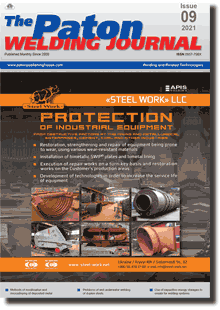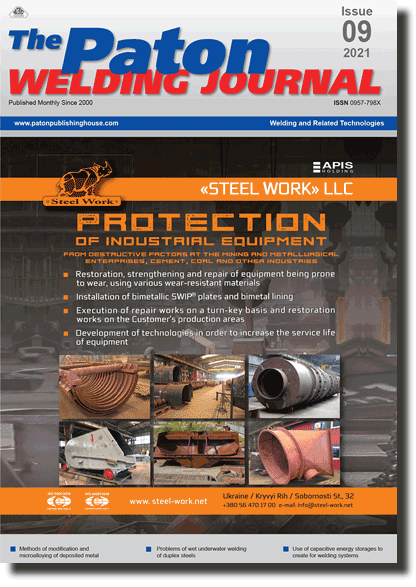Access for download PDF files for subscribers and for reviewers of scientometric bases.
Organization: Elsevier for content access(PDF files of journals released before 2024 are available for download from the website's archives))
Organization: Elsevier for content access(PDF files of journals released before 2024 are available for download from the website's archives))
| 2021 №09 (07) |
DOI of Article 10.37434/tpwj2021.09.08 |
2021 №09 (01) |

The Paton Welding Journal, 2021, #9, 49-55 pages
Three-dimensional visualization of the detected defects by eddy current computing tomography
O.O. Vertiy1 and V.M. Uchanin2
1National Aerospace University «Kharkiv Aviation Institute» 17 Chkalov Str., 61070, Ukraine. E-mail: alexey.vertiy@gmail.com
2G.V. Karpenko Physico-Mechanical Institute of NASU 5 Naukova Str., 79060, Lviv, Ukraine. E-mail: vuchanin@gmail.com
Abstract
Nondestructive computing tomography methods based on different physical phenomena are reviewed as an effective tool to solve many NDT problems in the context of NDE 4.0 revolution. Eddy current (EC) tomography principle and experimental set-up are presented to demonstrate the possibility to reconstruct tomography images related to the distribution of material electric conductivity. A riveted joint of two aluminium alloy sheets with 2 mm long artificial cracklike defects was selected as an example of complex enough inspected structure. Investigations were carried out with two types of eddy current probes (ECP) application: the first one — the traditional EC probe of absolute type with coaxial driving and sensing coils, and the second — low-frequency double differential EC probe of MDF 1201 type. The set of vertical (orthogonal to the inspected surface) slices for the rivet zone were obtained to demonstrate the effectiveness of EC tomography. The horizontal slices were analyzed to demonstrate the possibility to produce tomography images at different depths. Two-layer structures, consisting of upper sheets with thicknesses from 0 to 8 mm and 5 mm thick lower sheath with a cracklike defect were applied to reconstruct the vertical tomography slices using double differential EC probes. The latter results demonstrate the great depth of evaluation with application of ECP of double differential type and the possibility to estimate the detected defect size and distance from the inspected surface. 34 Ref., 8 Figures.
Keywords: eddy current (EC) tomography, eddy current probe (EC probe), double differentiation EC probe, electric conductivity, tomography images, slices, riveted joints
Received 18.03.2021
References
1. Liao, Y., Deschamps, F., Loures, E.F.R., Ramos, L.F.P. (2017) Past, present and future of Industry 4.0 - a systematic literature review and research agenda proposal. Intern. J. of Production Research, 55(12), 3609-3629. https://doi.org/10.1080/00207543.2017.13085762. Drath, R., Horch, A. (2014) Industrie 4.0: Hit or Hype. IEEE Industrial Electronics Magazine, 8(2), 56-58. https://doi.org/10.1109/MIE.2014.2312079
3. Yurchak, A. (2019) Far from the neighbours: why Ukraine lags behind in the sphere of industrial development 4.0. Ekonomichna Pravda. https://www.epravda.com.ua/rus/columns/2019/11/5/653346.
4. Singh, R. (2019) The next revolution in nondestructive testing and evaluation: What and how. Materials Evaluation, 77(1), 45-50.
5. Vrana, J. (2020) NDE Perception and еmerging reality: NDE 4.0 value еxtraction, Materials Evaluation, 78(7), 835-851. https://doi.org/10.32548/2020.me-04131
6. Naida, V.L., Uchanin, V.N., Mozhukhin, A.A. et al. (2008) Development of elements of a system of automated eddy current testing of collector bridges in nuclear power plants. Tekh. Diagnost. i Nerazrush. Kontrol, 3, 21-24 [in Russian].
7. Lutcenko, G., Uchanin, V., Mischenko, V., Opanasenko, A. (2012) Eddy currents versus magnetic particles. In: Proc. of 18th World Conf. on Nondestructive Testing, Durban, www. ndt.com.
8. Dolinenko, V.V., Shapovalov, E.V., Skuba, T.G. et al. (2017) Robotic system of non-destructive eddy-current testing of complex geometry products. The Paton Welding J., 5-6, 60- 67. https://doi.org/10.15407/as2017.06.10
9. Lysenko, Ju., Eremenko, V., Kuts, Yu. et al. (2020) Advanced signal processing methods for inspection of aircraft structural materials. Transact. on Aerospace Research, 2(259), 27-35. https://doi.org/10.2478/tar-2020-0008
10. Hounsfield, G. N. (1972) A method and apparatus for examination of a body by radiation such as X-ray or gamma radiation. British Pat. 1283915. British Patent Office, London.
11. Vajnberg, E.I., Klyuev, V.V., Kurozaev, V.P. (1986) Industrial X-ray computed tomography: Book. Devices for non-destructive testing of materials and products: Refer. book. Ed. by V.V. Klyuev. 2nd Ed., Moscow, Vol. 1 [in Russian].
12. Vajnberg, E.I., Kazak, I.A., Kurozaev, V.P. (1981) Reconstruction of internal space structure of objects by integral projections in real time. DAN SSSR, 257(1), 89-94 [in Russian].
13. Reimers, P., Goebbels, J. (1983) New possibilities of nondestructive evaluation by X-ray computed tomography. Materials Evaluation, 42(6), 732-737
14. Maire, E., Buffiere, J., Salvo, L. et al. (2001) On the application of X-ray microtomography in the field of materials science. Advanced Engineering Materials, 3(8), 539-546. https://doi.org/10.1002/1527-2648(200108)3:8<539::AID-ADEM539>3.0.CO;2-6
15. Nazarchuk, Z.T., Koshovy, V.V., Krivin, E.V., Romanyshyn, I.M. (1999) Ultrasonic tomography, technologies for NDT and monitoring of material degradation. In: Proc. Joint EC IAEA Specialists Meeting on NDT Methods for Monitoring Degradation. Petten, The Netherlands, 79-89.
16. Koshovyy, V. V., Nazarchuk, Z. T. (2001) Estimating the predefective state of a material using methods of ultrasonic computerized tomography. Materials Sci., 37(2), 279-293. https://doi.org/10.1023/A:1013219011254
17. Koshevoj, V.V., Romanishin, I.M., Romanishin, R.I., Sharamaga, R.V. (2010) Ultrasonic computer tomography based on recording of a signal scattered by material structure. Pt 1. Tekh. Diagnost. i Nerazrush. Kontrol, 2, 37-42 [in Russian].
18. Koshevoj, V.V., Romanishin, I.M., Romanishin, R.I., Sharamaga, R.V. (2010) Ultrasonic computer tomography based on recording of a signal scattered by material structure. Pt 2. Tekh. Diagnost. i Nerazrush. Kontrol, 3, 19-24 [in Russian].
19. (2011) Subsurface sensing. Ed. by A.S.Turk, A.K., Hocaoglu, A.A. Vertiy, John Wiley & Sons, Inc.
20. Vertiy, A., Gavrilov, S., Voynovskyy, I., Stepanyuk, V. (2002) The millimeter wave tomography application for the subsurface imaging. Int. J. of Infrared and Millimeter Waves. 23(10), 1413-1444. https://doi.org/10.1023/A:1020321301479
21. Gavrilov, S.P., Vertiy, A.A. (1997) Application of tomography method in millimeter wavelengths band: I. Theoretical. Int. J. Infrared Millimeter Waves, 18(9), 1739-1760. https://doi.org/10.1007/BF02678285
22. Vertiy, A.A., Gavrilov, S.P. (1997) Application of tomography method in millimeter wavelengths band: II. Experimental. Int. J. Infrared Millimeter Waves, 18(9), 1761-1781. https://doi.org/10.1007/BF02678286
23. Vertiy, A., Gavrilov, S., Voynovskyy, I. et al. (2004) Subsurface imaging by deep penetrating eddy current tomography. Fizychni Metody ta Zasoby Kontrolyu Seredovyshch, Materialiv ta Vyrobiv, 9, 123-127 [in Russian].
24. Vertiy, A.A., Gavrilov, S.P., Voynovskyy, I.V. et al. (2004) Deep penetrating eddy current tomography for subsurface imaging. In: Proc. of 10th Int. Workshop on Electromagnetic Evaluation. Michigan, USA. 91-92.
25. Tamburrino, A. Rubinacci, G. (2002) A new non-iterative inversion method for electrical resistance tomography. Inverse Problems, 18(6), 1809-1829. https://doi.org/10.1088/0266-5611/18/6/323
26. Tamburrino, A., Soleimani, M. (2006) Shape reconstruction in magnetic induction tomography using multifrequency data. Int. J. of Informaton and Systems Sci., 2(3), 343-353.
27. Tamburrino, A., Rubinacci, G., Soleimani, M., Lionheart, W. (2003) Non iterative inversion method for electrical resistance, capacitance and inductance tomography. In: 3rd World Congress on Industrial Process Tomography, Banff, Canada, 233-238.
28. Tamburrino, A., Rubinacci, G. (2006) Fast methods for quantitative eddy-current tomography of conductive materials. IEEE Transact. on Magnetics, 42(8), 2017-2028. https://doi.org/10.1109/TMAG.2006.877542
29. Uchanin, V.N. (2010) Eddy current surface probes: Expanded classification, comparative analysis and characteristic examples of realization. (Review). Tekh. Diagnost. i Nerazrush. Kontrol, 4, 24-29 [in Russian].
30. Uchanin, V.M. (2007) Specific features of the space distribution of the signal of an eddy-current converter caused by cracks of different lengths. Materials Sci., 43, 591-595. https://doi.org/10.1007/s11003-007-0068-2
31. Uchanin, V.M. (2013) Eddy-current surface probes of double differention type. Lviv, Spolom [in Ukrainian].
32. Mook, G., Hesse, J., Uchanin, V. (2007) Deep penetrating eddy currents and probes. Materials Testing, 49(5), 258-264. https://doi.org/10.3139/120.100810
33. Uchanin, V. (2006) Eddy current methods of detection of defects in the zone of rivets of multilayer aircraft structures. Tekh. Diagnost. i Nerazrush. Kontrol, 2, 3-12 [in Russian].
34. Uchanin, V. (2020) Detection of the fatigue cracks initiated near the rivet holes by eddy current inspection techniques. Transact. on Aerospace Research, 1(258), 47-58. https://doi.org/10.2478/tar-2020-0010
Suggested Citation
O.O. Vertiy and V.M. Uchanin (2021) Three-dimensional visualization of the detected defects by eddy current computing tomography. The Paton Welding J., 09, 49-55.The cost of subscription/purchase order journals or individual articles
| Journal/Currency | Annual Set | 1 issue printed |
1 issue |
one article |
| TPWJ/USD | 384 $ | 32 $ | 26 $ | 13 $ |
| TPWJ/EUR | 348 € | 29 € | 24 € | 12 € |
| TPWJ/UAH | 7200 UAH | 600 UAH | 600 UAH | 280 UAH |
| AS/UAH | 1800 UAH | 300 UAH | 300 UAH | 150 UAH |
| AS/USD | 192 $ | 32 $ | 26 $ | 13 $ |
| AS/EUR | 180 € | 30 € | 25 € | 12 € |
| SEM/UAH | 1200 UAH | 300 UAH | 300 UAH | 150 UAH |
| SEM/USD | 128 $ | 32 $ | 26 $ | 13 $ |
| SEM/EUR | 120 € | 30 € | 25 € | 12 € |
| TDNK/UAH | 1200 UAH | 300 UAH | 300 UAH | 150 UAH |
| TDNK/USD | 128 $ | 32 $ | 26 $ | 13 $ |
| TDNK/EUR | 120 € | 30 € | 25 € | 15 € |
AS = «Automatic Welding» - 6 issues per year;
TPWJ = «PATON WELDING JOURNAL» - 12 issues per year;
SEM = «Electrometallurgy Today» - 4 issues per year;
TDNK = «Technical Diagnostics and Non-Destructive Testing» - 4 issues per year.


